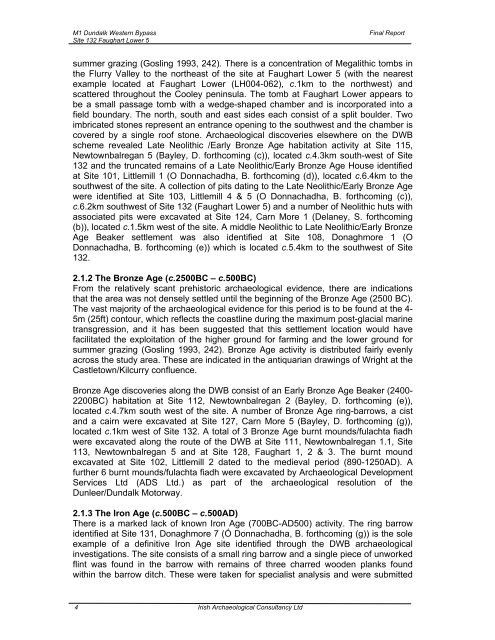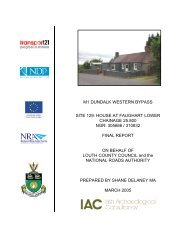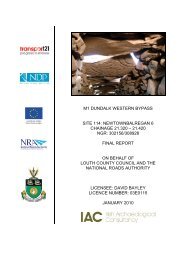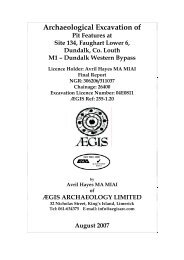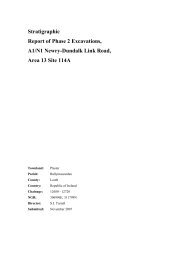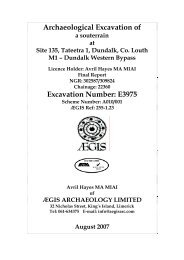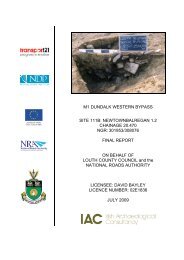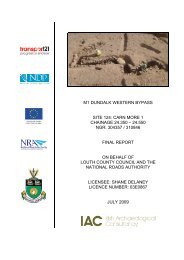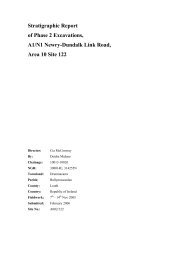Faughart Lower 5 Final Report - ASI Louth
Faughart Lower 5 Final Report - ASI Louth
Faughart Lower 5 Final Report - ASI Louth
Create successful ePaper yourself
Turn your PDF publications into a flip-book with our unique Google optimized e-Paper software.
M1 Dundalk Western Bypass<br />
Site 132 <strong>Faughart</strong> <strong>Lower</strong> 5<br />
<strong>Final</strong> <strong>Report</strong><br />
summer grazing (Gosling 1993, 242). There is a concentration of Megalithic tombs in<br />
the Flurry Valley to the northeast of the site at <strong>Faughart</strong> <strong>Lower</strong> 5 (with the nearest<br />
example located at <strong>Faughart</strong> <strong>Lower</strong> (LH004-062), c.1km to the northwest) and<br />
scattered throughout the Cooley peninsula. The tomb at <strong>Faughart</strong> <strong>Lower</strong> appears to<br />
be a small passage tomb with a wedge-shaped chamber and is incorporated into a<br />
field boundary. The north, south and east sides each consist of a split boulder. Two<br />
imbricated stones represent an entrance opening to the southwest and the chamber is<br />
covered by a single roof stone. Archaeological discoveries elsewhere on the DWB<br />
scheme revealed Late Neolithic /Early Bronze Age habitation activity at Site 115,<br />
Newtownbalregan 5 (Bayley, D. forthcoming (c)), located c.4.3km south-west of Site<br />
132 and the truncated remains of a Late Neolithic/Early Bronze Age House identified<br />
at Site 101, Littlemill 1 (O Donnachadha, B. forthcoming (d)), located c.6.4km to the<br />
southwest of the site. A collection of pits dating to the Late Neolithic/Early Bronze Age<br />
were identified at Site 103, Littlemill 4 & 5 (O Donnachadha, B. forthcoming (c)),<br />
c.6.2km southwest of Site 132 (<strong>Faughart</strong> <strong>Lower</strong> 5) and a number of Neolithic huts with<br />
associated pits were excavated at Site 124, Carn More 1 (Delaney, S. forthcoming<br />
(b)), located c.1.5km west of the site. A middle Neolithic to Late Neolithic/Early Bronze<br />
Age Beaker settlement was also identified at Site 108, Donaghmore 1 (O<br />
Donnachadha, B. forthcoming (e)) which is located c.5.4km to the southwest of Site<br />
132.<br />
2.1.2 The Bronze Age (c.2500BC – c.500BC)<br />
From the relatively scant prehistoric archaeological evidence, there are indications<br />
that the area was not densely settled until the beginning of the Bronze Age (2500 BC).<br />
The vast majority of the archaeological evidence for this period is to be found at the 4-<br />
5m (25ft) contour, which reflects the coastline during the maximum post-glacial marine<br />
transgression, and it has been suggested that this settlement location would have<br />
facilitated the exploitation of the higher ground for farming and the lower ground for<br />
summer grazing (Gosling 1993, 242). Bronze Age activity is distributed fairly evenly<br />
across the study area. These are indicated in the antiquarian drawings of Wright at the<br />
Castletown/Kilcurry confluence.<br />
Bronze Age discoveries along the DWB consist of an Early Bronze Age Beaker (2400-<br />
2200BC) habitation at Site 112, Newtownbalregan 2 (Bayley, D. forthcoming (e)),<br />
located c.4.7km south west of the site. A number of Bronze Age ring-barrows, a cist<br />
and a cairn were excavated at Site 127, Carn More 5 (Bayley, D. forthcoming (g)),<br />
located c.1km west of Site 132. A total of 3 Bronze Age burnt mounds/fulachta fiadh<br />
were excavated along the route of the DWB at Site 111, Newtownbalregan 1.1, Site<br />
113, Newtownbalregan 5 and at Site 128, <strong>Faughart</strong> 1, 2 & 3. The burnt mound<br />
excavated at Site 102, Littlemill 2 dated to the medieval period (890-1250AD). A<br />
further 6 burnt mounds/fulachta fiadh were excavated by Archaeological Development<br />
Services Ltd (ADS Ltd.) as part of the archaeological resolution of the<br />
Dunleer/Dundalk Motorway.<br />
2.1.3 The Iron Age (c.500BC – c.500AD)<br />
There is a marked lack of known Iron Age (700BC-AD500) activity. The ring barrow<br />
identified at Site 131, Donaghmore 7 (Ó Donnachadha, B. forthcoming (g)) is the sole<br />
example of a definitive Iron Age site identified through the DWB archaeological<br />
investigations. The site consists of a small ring barrow and a single piece of unworked<br />
flint was found in the barrow with remains of three charred wooden planks found<br />
within the barrow ditch. These were taken for specialist analysis and were submitted<br />
4<br />
Irish Archaeological Consultancy Ltd


